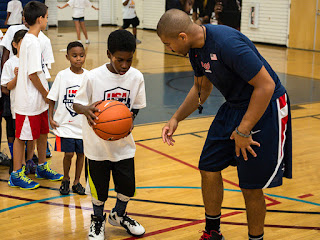As a coach, one of your most important responsibilities is adjusting your approach based on the age, stage, and development of your athletes. Whether you're working with 8-year-olds or guiding 17-year-olds toward elite competition, the “how” behind your practices matters just as much as the “what.”
Here’s a breakdown of age-specific coaching strategies, along with key concepts every coach should master to unlock the full potential of young players.
Ages 8–10: Joy Comes First
At this stage, your mission is clear: spark the love for the game.
-
Practice frequency: 2x per week
-
Focus:
-
40% Fundamental Skills – Dribbling, shooting, passing
-
60% Free play and creative games
-
This is the golden age of motor learning, so prioritize fun, imagination, and movement variety. Avoid over-structuring. Let kids explore the court through games that teach implicitly—tag, relays, obstacle courses, and small competitions that make them smile while they improve.
🧠 Tip: Encourage participation in multiple sports. It boosts coordination, balance, and social learning.
Ages 10–12: Structured Freedom
Players start craving more structure, but joy and exploration are still central.
-
Practice frequency: 2x per week
-
Focus:
-
60% Fundamental Skills
-
40% Free play (now with added rules and structure)
-
Your creativity as a coach still matters—games should remain fun, but now serve specific purposes. Layer in small-sided games (2v2, 3v3) and start introducing decision-making through constraints.
🔁 Still encourage multisport involvement. It pays long-term dividends in motor development and injury prevention.
Ages 12–14: Foundations Meet Tactics
Now the game begins to “look like basketball.”
-
Practice frequency: 3x per week
-
Focus:
-
80% Skill Work
-
20% Game Play
-
-
New elements: Basic group tactics (up to 3 players), team coordination
Players begin forming identity, but early specialization is discouraged. Everyone should experience all five positions—this builds versatility and deep game understanding.
📌 Note: A player’s “basketball age” (how long they've been playing) can matter more than biological age when assessing potential. A 14-year-old with one year of experience might have more upside than one playing for four years.
Ages 14–16: Introducing Role and Responsibility
Performance starts to matter more, but development is still the priority.
-
Practice frequency: 4x per week (including 1 strength-focused session)
-
Focus:
-
Continue building core skills under pressure
-
Begin position specialization
-
Introduce team tactics and game analysis
-
Players start thinking tactically reading the game, understanding timing and spacing, and reacting appropriately. This is the stage where mental growth—handling pressure, understanding mistakes, and working with feedback—takes center stage.
🧠 “Tactical IQ” becomes a teachable skill. Don’t just drill—explain the “why.”
Ages 16–18: Preparation for Adult Basketball
The margin for error shrinks, and performance expectations rise.
-
Practice frequency: 5 basketball sessions + 2 strength workouts
-
Focus:
-
Advanced fundamentals
-
Individual, group, and team tactics
-
Defined roles and identity
-
Players at this stage should be fluent in the language of basketball. They must know how to contribute to a team both technically and tactically. Still, the fundamentals remain essential—passing, shooting, footwork, and ball-handling under stress.
Coaching Wisdom That Transcends Age
No matter the age group, here are core principles for long-term success:
🔹 Train Smart, Not Just Hard
How we practice determines 80% of a player’s success. Every challenge is an opportunity. Problems aren’t obstacles—they're stepping stones.
🔹 Emphasize Contact and Footwork
Teach players to handle physical contact with confidence. Strong footwork creates balance and body control, which helps players absorb or deliver contact more effectively.
📘 Rule of thumb: The player who makes contact first (offensively or defensively) often wins the play.
🔹 Defense Is Intelligence
Modern defense isn’t just effort—it’s anticipation, speed of perception, and decision-making. Teach concepts like:
-
Closeouts
-
Help-side positioning
-
Boxing out
-
On-ball defense
Train players to see the game before it happens.
🔹 Offense Is Timing and Spacing
Skill alone doesn’t score. Teach players to:
-
React at the right time
-
Maintain floor balance
-
Understand where and when to move
Decision-making makes skills unstoppable.
Let Players Be Creative—But with Purpose
Freedom is essential. Players need space to experiment and make mistakes. But as a coach, always know:
-
Why you're allowing that freedom
-
What you're reinforcing through it
🧠 Basketball is a game of errors. Embrace them as teaching tools.
Feedback: The Silent Superpower
Done right, feedback changes players. Done wrong, it undermines them.
-
Don’t interrupt heated moments during games
-
Use pauses or stoppages for corrections
-
Deliver feedback within 24–48 hours for maximum impact
-
Avoid repeating the same critique more than twice—confidence matters
Final Thoughts: What Makes Great Coaches
Great coaches do more than run drills. They:
-
Adapt to each player's stage and needs
-
Balance joy with structure
-
Understand when to push and when to listen
-
Teach beyond the sport—character, grit, discipline
Hard work builds character. It raises pain tolerance. It breaks limits. And most importantly—it works.
Your influence as a coach extends far beyond the scoreboard. Be the guide who helps players not only master the game but love it for life.


Comments
Post a Comment